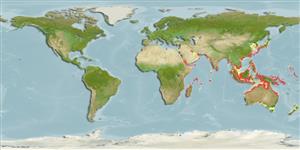>
Carangiformes (Jacks) >
Carangidae (Jacks and pompanos) > Caranginae
Etymology: Atropus: The name of the Parcae, fates of Roman mythology (Ref. 45335).
Eponymy: In Greek mythology, Atropos -known as the ‘inflexible’ or ‘inevitable’ -was the oldest of the Three Fates. In Greek mythology, Atropos -known as the ‘inflexible’ or ‘inevitable’ -was the oldest of the Three Fates. (Ref. 128868), visit book page.
More on authors: Bloch & Schneider.
Environment: milieu / climate zone / Tiefenbereich / distribution range
Ökologie
seewasser pelagic-neritic; amphidrom (Ref. 51243); tiefenbereich 5 - 100 m (Ref. 52753). Tropical; 40°N - 12°S, 47°E - 143°E
Indo-West Pacific.
Length at first maturity / Size / Gewicht / Alter
Geschlechtsreife: Lm 21.0 range ? - ? cm
Max length : 31.6 cm TL Männchen/unbestimmt; (Ref. 121654)
Rückenflossenstacheln (insgesamt) : 9; Rückenflossenweichstrahlen (insgesamt) : 21 - 22; Afterflossenstacheln: 3; Afterflossenweichstrahlen: 17 - 18. This species is easily recognized by its long pelvic fin which fit into a groove along the midline of the belly when depressed. Scutes are present along its straight lateral line. Adult males have prolonged middle rays in the soft dorsal and anal fins. This species attains 25 cm in SL.
Body shape (shape guide): short and / or deep; Cross section: compressed.
Adults are common in shallow coastal waters where they often swim near the surface. They feed mainly on shrimps, copepods, decapod crustaceans and small fish.
Life cycle and mating behavior
Geschlechtsreife | Fortpflanzung | Ablaichen | Eier | Fecundity | Larven
Masuda, H., K. Amaoka, C. Araga, T. Uyeno and T. Yoshino, 1984. The fishes of the Japanese Archipelago. Vol. 1. Tokai University Press, Tokyo, Japan. 437 p. (text). (Ref. 559)
IUCN Rote Liste Status (Ref. 130435: Version 2025-1)
Bedrohung für Menschen
Harmless
Nutzung durch Menschen
Fischereien: weniger kommerziell
Tools
Zusatzinformationen
Download XML
Internet Quellen
Estimates based on models
Preferred temperature (Ref.
123201): 23.5 - 29.2, mean 28.2 °C (based on 1522 cells).
Phylogenetic diversity index (Ref.
82804): PD
50 = 0.5312 [Uniqueness, from 0.5 = low to 2.0 = high].
Bayesian length-weight: a=0.02089 (0.01199 - 0.03640), b=2.86 (2.71 - 3.01), in cm total length, based on LWR estimates for this species & (Sub)family-body (Ref.
93245).
Trophic level (Ref.
69278): 3.6 ±0.52 se; based on food items.
Generation time: 2.0 ( na - na) years. Estimated as median ln(3)/K based on 2
growth studies.
Widerstandsfähigkeit (Ref.
120179): hoch, Verdopplung der Population dauert weniger als 15 Monate. (Preliminary K or Fecundity.).
Fishing Vulnerability (Ref.
59153): Low vulnerability (18 of 100).
🛈
Nutrients (Ref.
124155): Calcium = 197 [92, 426] mg/100g; Iron = 1.79 [0.95, 3.80] mg/100g; Protein = 18.6 [17.3, 19.9] %; Omega3 = 0.247 [0.129, 0.485] g/100g; Selenium = 51 [23, 115] μg/100g; VitaminA = 14.4 [3.5, 52.1] μg/100g; Zinc = 1.14 [0.73, 1.81] mg/100g (wet weight);
